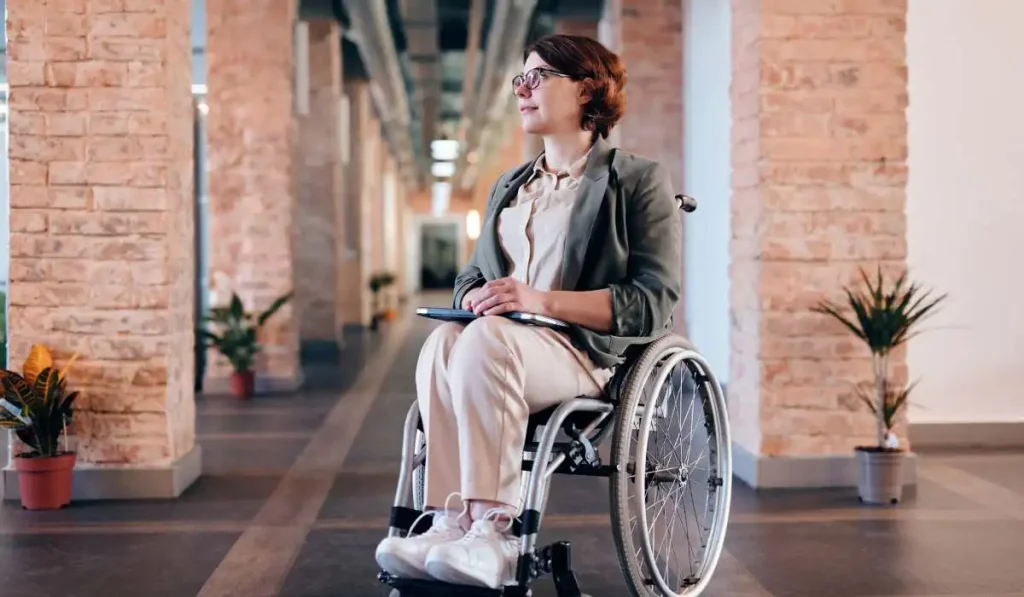When it comes to creating a home that combines comfort and accessibility, choosing the right flooring is key. Today, we’re zeroing in on a topic that’s super important for folks who use wheelchairs: finding the best floor that makes life easier and keeps things looking snazzy.
Imagine this: you’re zipping through your home, but instead of a smooth ride, it’s more like an off-road adventure. Not fun, right? That’s why the floor beneath your wheels matters—a lot. It’s not just about the color or style; it’s about how it can handle the roll and hustle of daily life on wheels.
So, whether you’re doing a full-on reno or just dreaming about the perfect pad, let’s dive into what makes a floor fab for wheelchairs. We’re talking slip resistance, durability, and, of course, that cool factor that makes your space shine. Buckle up, it’s going to be a smooth ride!
Understanding Slip Resistance: The Key to Safe Wheeling
When it comes to picking the perfect floor for a wheelchair, one word should always be at the front of your mind: slip resistance. It’s the superhero trait of flooring, keeping wheels firmly gripped and preventing any unwanted slip-and-slide moments.
So, what’s the secret sauce behind slip-resistant floors? It’s all about the friction coefficient, a fancy term that measures how much grip a surface offers. Think of it like the tread on your favorite sneakers; you wouldn’t want to sprint in socks on a polished floor, right? The same goes for wheelchairs. Floors with a higher friction coefficient are like those trusty sneakers, giving you the control and stability you need.
Now, you might be wondering, “What floors have this magical coefficient?” Well, we’ve got options! Hardwood floors, laminate boards, certain ceramic tiles, and vinyl – they’re all part of the slip-resistant family. But here’s a pro tip: always check the manufacturer’s specs to see the friction coefficient. It’s like checking the nutrition label before you buy – you want to know what you’re rolling on.
In the next sections, we’ll break down these materials, so you can make the best choice for your home. Whether you’re after the warm vibes of wood or the cool, clean look of tiles, we’ve got the lowdown on what will work best for your wheels. Stay tuned, because we’re about to get into the nitty-gritty of each flooring type, ensuring you’re well-equipped to make your home as wheelchair-friendly as it can be.
Exploring Wood and Laminate Flooring: Timeless Charm Meets Wheelchair Accessibility
Let’s talk about wood flooring first. It’s like that classic song that never gets old—timeless, elegant, and always in style. Wood floors are a solid pick for many, and they’ve got a rep for being durable and long-lasting.
Plus, they just look fantastic, don’t they? But here’s the scoop for wheelchair users: while wood is durable, it’s also about keeping those wheels clean. Trekking in dirt from the outside can scratch up that beautiful surface, so a little wipe-down of your wheels can keep your floors looking top-notch.
Now, if you’re thinking wood sounds great but maybe a bit pricey, laminate wood flooring might just be your new best friend. It’s like the budget-friendly cousin of hardwood that still looks sharp.
But before you say “yes” to laminate, there’s one question you’ve gotta ask: “What’s the AC Rating for this floor?” This rating is all about how tough the flooring is.
It’s tested for all sorts of things like scratches, burns, and stains.
For homes that see a lot of action (and let’s be real, which home doesn’t?), you’ll want to aim for a higher AC number. It’s like choosing armor for your floor—more protection against the daily hustle and bustle.
Laminate that’s rated AC3/23 is fab for homes, while AC3/31 can even handle some commercial action, like hotel rooms or small offices. So, whether it’s just you rolling around or you’ve got a whole squad of wheelchairs and walkers, laminate’s got you covered.
In the next bit, we’ll glide into the world of vinyl flooring. It’s got some tricks up its sleeve that might just make it the MVP of wheelchair-friendly flooring. Stay tuned, because we’re about to lay down some serious knowledge on why vinyl could be the smooth operator your home needs.
The Versatility of Vinyl Flooring: A Wheelchair-Friendly Wonder
Next up on our flooring journey, we’re stepping into the world of vinyl. Now, vinyl might not be the first thing that pops into your mind when you think of stylish flooring, but hear us out. Vinyl flooring is like that multi-talented friend we all have. It’s got a lot going for it, especially for wheelchair users.
First off, vinyl flooring is a breeze to maintain. It’s like that low-maintenance friend who’s always easy-going and drama-free. Spill something on it? No problem, a quick wipe and it’s as good as new. Plus, it’s water-resistant, making it a great choice for areas like the kitchen or bathroom where splashes and spills are part of the daily routine.
But not all vinyl is created equal. Inlaid sheet vinyl and tiles tend to be more slip-resistant than sheet vinyl flooring, giving you that extra grip and stability. And if you’re all about the details, vinyl tiles with a foam backing are also slip-resistant and install just like laminate flooring boards. They might be a bit pricier, but hey, can you really put a price on safety and comfort?
One more thing to love about vinyl is its versatility. If a tile gets damaged, you can simply replace it without having to redo the entire floor. And when it comes to cleaning, vinyl is a champ. Got a scuff mark? Just grab a soft pencil eraser and rub it off. Easy peasy!
In our next section, we’ll be talking about ceramic tiles. They’re durable, water-resistant, and can add a touch of elegance to any room. But are they a good fit for wheelchair users? Stick around to find out!
Ceramic Tiles: A Durable Option with a Dash of Elegance
Now, let’s shift gears and talk about ceramic tiles. They’re like the little black dress of flooring—classy, versatile, and always in style. But the real question is, are they a good fit for wheelchair users?
Ceramic tiles have a lot going for them. They’re more water-resistant than hardwood or laminates, making them a great choice for areas like the kitchen or bathroom. But when it comes to tile size, smaller is better. A 2-inch square tile is ideal because it has enough grout lines to improve traction. Think of it like the treads on a tire—the more lines, the better the grip.
But here’s the catch: larger tiles can be more fragile and likely to crack under the weight of a wheelchair. And while tiles with textured surfaces are more slip-resistant, they can be a bit tricky to clean. Plus, if they’re in a bathroom, kitchen, or any area around water, you’ll need to be extra careful about slipping.
So, while ceramic tiles can add a touch of elegance to any room, they might not be the best choice for every wheelchair user. But don’t worry, we’ve still got one more flooring option to explore: carpeting. It’s soft, cozy, and can be a great choice for some. Stay tuned to find out if it could be the right fit for you!
Carpeting: Cozy Comfort for Wheelchair Users
Alright, let’s roll onto the topic of carpeting. It’s like a warm hug for your home, offering a cozy touch that can make any space feel more inviting. But when it comes to wheeling around, not all carpets are created equal.
For those using wheelchairs, the pile of the carpet is super important. High-pile carpets are a no-go; they’re like trying to push through a sandy beach. Instead, you want to look for a very low pile carpet or a commercial carpet made for high traffic areas. These types of carpets are the superheroes for wheelchair users, providing a firm surface that’s still soft underfoot.
Now, let’s talk installation. Carpeting needs to be firmly attached to the sub-floor, and the pile should be less than 1/2-inch high to keep things rolling smoothly. But even the best carpet can have its kryptonite—seams that don’t stay put can create humps and bumps that are not only annoying but can be downright dangerous.
Durability is another biggie. Wheelchairs are heavy, and over time, they can leave tracks in the carpet. That’s why choosing the right type of carpet is key. And if you’re in an area where water is a common guest, like near a bathroom or kitchen, carpet might not be your best bet.
But for those who love the feel of carpet under their wheels, there’s a solution: commercial carpet tiles. They’re like the best of both worlds—firm enough for easy wheeling and easy to replace if one gets damaged. Plus, they come with a vinyl backing, so no need for extra padding.
So, there you have it. Whether you’re all about the elegance of wood, the practicality of vinyl, the durability of ceramic, or the comfort of carpet, there’s a flooring option out there that’s just right for your wheels. Remember, it’s all about finding that sweet spot between functionality, safety, and style. Happy flooring hunting!
The Importance of Quality Installation: Ensuring Longevity and Safety
Now that we’ve explored the different types of flooring, let’s talk about something that’s just as important: installation. It’s like the foundation of a house—if it’s not done right, everything built on top of it can be shaky.
The quality of installation can make a big difference in how your flooring performs over time. Tiles or laminate boards that come unglued, pop up, or crack can be safety hazards for everyone. Carpets that bunch or tear can create barriers that make navigation difficult. Even hardwood floors can present issues if not installed correctly—they can become slippery when wet and can swell and buckle, creating safety risks.
So, how do you ensure a quality installation? Start by finding a responsible installer. This is someone who has experience, positive customer reviews, and a reputation for doing the job right. Don’t be afraid to ask for references and check their previous work.
Next, get a warranty on the product when you buy flooring. This is like an insurance policy for your floors. If something goes wrong due to a manufacturing defect, you’ll be covered.
Remember, the best floor for a wheelchair is not just about the type of flooring, but also about how it’s installed. A well-installed floor will provide a smooth, safe surface for wheelchair users for years to come.
Wrapping Up: Choosing the Best Floor for a Wheelchair User
We’ve journeyed through the world of flooring, exploring the pros and cons of different materials and how they can impact wheelchair users. From the classic elegance of wood and laminate to the practicality of vinyl, the durability of ceramic tiles, and the cozy comfort of carpeting, we’ve seen that there’s no one-size-fits-all answer. The best floor for a wheelchair user depends on a variety of factors, including personal preferences, budget, and specific needs.
Remember, slip resistance is a key factor to consider for safety. The friction coefficient of the flooring material can make a big difference in preventing slips and falls. Also, consider the durability of the material, especially if the floor will be subjected to heavy traffic or use by power wheelchairs or walkers.
When it comes to installation, quality is crucial. A poorly installed floor can lead to safety hazards and may not last as long. Always choose a reputable installer and consider getting a warranty on the product for peace of mind.
In the end, the best floor for a wheelchair user is one that provides a smooth, safe surface for navigation, is easy to maintain, and fits well with the style and decor of the home. It’s about finding the right balance between functionality, safety, and aesthetics.
We hope this guide has been helpful in your quest to find the best floor for a wheelchair user. Happy flooring hunting, and here’s to finding the perfect fit for your home!
Frequently Asked Questions About Wheelchair-Friendly Flooring
What is the best floor for a wheelchair user?
The best floor for a wheelchair user combines slip resistance, durability, and ease of maintenance. Options include hardwood, laminate, vinyl, and low-pile carpet.
How important is slip resistance for wheelchair flooring?
Slip resistance is crucial for safety. Flooring with a high friction coefficient helps prevent slips and ensures better wheelchair control.
Can laminate flooring work well for wheelchairs?
Yes, laminate flooring with a high AC Rating is durable and can be a good choice for wheelchair users, offering ease of movement and resistance to wear.
Is carpet a bad choice for wheelchair users?
Not necessarily. Low-pile or commercial-grade carpet can be suitable for wheelchairs, providing it’s firmly installed and the pile is short for easier maneuverability.
What should I look for in vinyl flooring for a wheelchair?
Look for slip-resistant vinyl options like inlaid sheet vinyl or tiles with a foam backing. These provide better traction and are easier to maintain.
Why is the quality of flooring installation important?
Proper installation ensures the longevity and safety of the flooring. Poorly installed floors can lead to hazards and increased wear and tear.


